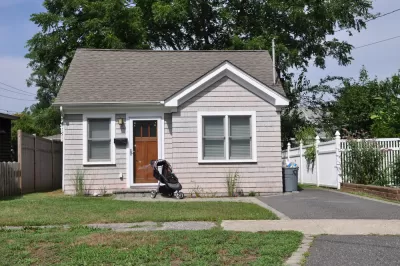Rising land costs, expensive materials, and onerous building and lot size requirements are making it harder to build small, affordable ‘starter homes’ in the United States.

For decades, the American Dream of homeownership rested on the concept of the ‘starter home:’ a simple, affordable, single-family house theoretically within financial reach of young people and families just starting out. But as Emily Badger writes in the New York Times, that path is increasingly closed off to most American households.
The nation has a deepening shortage of housing. But, more specifically, there isn’t enough of this housing: small, no-frills homes that would give a family new to the country or a young couple with student debt a foothold to build equity.
The rise in the cost of homes is due to a variety of factors, Badger continues. “Land costs have risen steeply in booming parts of the country. Construction materials and government fees have become more expensive. And communities nationwide are far more prescriptive today than decades ago about what housing should look like and how big it must be.” In some cases, requirements mandated by local ordinances raise the cost of construction.
Today, many builders say it’s becoming impossible to build small, low-cost homes on increasingly expensive land. Solutions include permitting the construction of more than one housing unit on a parcel and encouraging a variety of housing types such as townhomes, bungalows, and other ‘missing middle’ housing. “In the early 20th century, communities were effectively using all kinds of models to solve for affordable, entry-level housing. But the arrival of the car enabled people to move further out, and new planning ideas declared what would be built there.” With the midcentury suburban model growing more and more unsustainable, the future may well involve looking to the past.
FULL STORY: Whatever Happened to the Starter Home?

Maui's Vacation Rental Debate Turns Ugly
Verbal attacks, misinformation campaigns and fistfights plague a high-stakes debate to convert thousands of vacation rentals into long-term housing.

Planetizen Federal Action Tracker
A weekly monitor of how Trump’s orders and actions are impacting planners and planning in America.

San Francisco Suspends Traffic Calming Amidst Record Deaths
Citing “a challenging fiscal landscape,” the city will cease the program on the heels of 42 traffic deaths, including 24 pedestrians.

Defunct Pittsburgh Power Plant to Become Residential Tower
A decommissioned steam heat plant will be redeveloped into almost 100 affordable housing units.

Trump Prompts Restructuring of Transportation Research Board in “Unprecedented Overreach”
The TRB has eliminated more than half of its committees including those focused on climate, equity, and cities.

Amtrak Rolls Out New Orleans to Alabama “Mardi Gras” Train
The new service will operate morning and evening departures between Mobile and New Orleans.
Urban Design for Planners 1: Software Tools
This six-course series explores essential urban design concepts using open source software and equips planners with the tools they need to participate fully in the urban design process.
Planning for Universal Design
Learn the tools for implementing Universal Design in planning regulations.
Heyer Gruel & Associates PA
JM Goldson LLC
Custer County Colorado
City of Camden Redevelopment Agency
City of Astoria
Transportation Research & Education Center (TREC) at Portland State University
Jefferson Parish Government
Camden Redevelopment Agency
City of Claremont





























